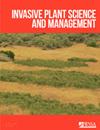入侵植物生物学2。枸杞
IF 1.2
4区 生物学
Q3 PLANT SCIENCES
引用次数: 0
摘要
Lycium属的名称源于希腊语lykion,意思是一种多刺灌木,源于小亚细亚一个古老国家的名称Lycia,在那里发现了类似的多刺灌木。具体的形容词ferocissimum来自拉丁语ferox,意思是“大胆”或“无畏”,指的是灌木非常多刺的性质(Green 1994;Parsons和Cuthbertson,2001年)。本文章由计算机程序翻译,如有差异,请以英文原文为准。
Biology of Invasive Plants 2. Lycium ferocissimum Miers
The name of the genus Lycium originates from the Greek name lykion for a thorny shrub, derived from Lycia, the name of an ancient country in Asia Minor where a similar spiny shrub was found. The specific epithet ferocissimum comes from the Latin ferox, meaning “bold” or “fearless,” referring to the very spiny nature of the shrub (Green 1994; Parsons and Cuthbertson 2001).
求助全文
通过发布文献求助,成功后即可免费获取论文全文。
去求助
来源期刊

Invasive Plant Science and Management
PLANT SCIENCES-
CiteScore
2.20
自引率
9.10%
发文量
24
审稿时长
6-12 weeks
期刊介绍:
Invasive Plant Science and Management (IPSM) is an online peer-reviewed journal focusing on fundamental and applied research on invasive plant biology, ecology, management, and restoration of invaded non-crop areas, and on other aspects relevant to invasive species, including educational activities and policy issues. Topics include the biology and ecology of invasive plants in rangeland, prairie, pasture, wildland, forestry, riparian, wetland, aquatic, recreational, rights-of-ways, and other non-crop (parks, preserves, natural areas) settings; genetics of invasive plants; social, ecological, and economic impacts of invasive plants and their management; design, efficacy, and integration of control tools; land restoration and rehabilitation; effects of management on soil, air, water, and wildlife; education, extension, and outreach methods and resources; technology and product reports; mapping and remote sensing, inventory and monitoring; technology transfer tools; case study reports; and regulatory issues.
 求助内容:
求助内容: 应助结果提醒方式:
应助结果提醒方式:


